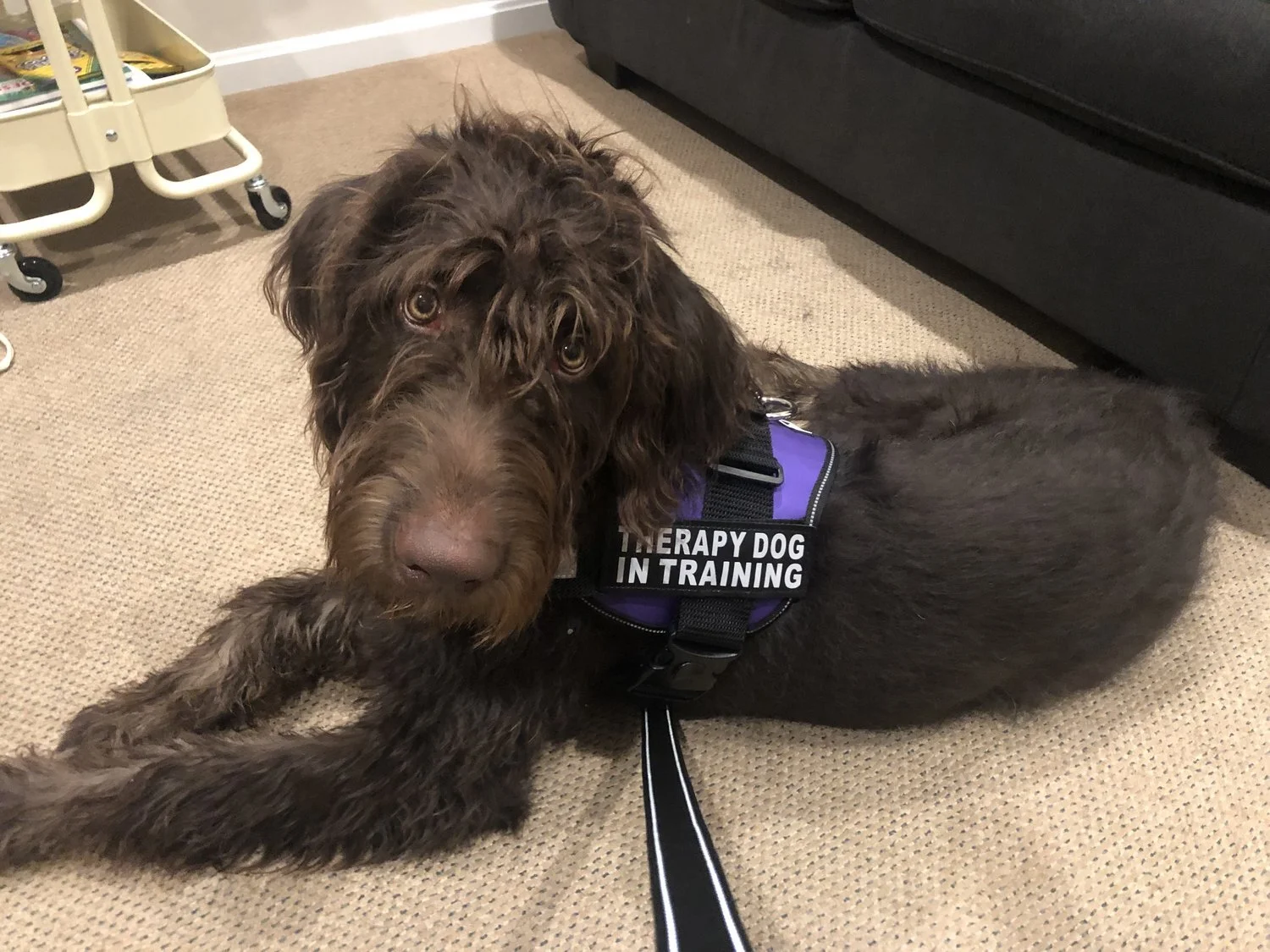Is There Specific Training My Dog Needs to Become a Therapy Dog?
Short Answer: No.
Long, ethical and less likely to get you in long-term trouble answer: Yes.
You might be surprised to learn, there is no regulating body for therapy dogs. Same with service dogs. No one controls the training they "must" go through to be working dogs in the helping field. There are many websites out there claiming to register your dog and give it special identification. These websites are charging people to give them certificates and patches that are essentially useless outside of show. Yes, maybe you like the vest (I just ordered Franklin one from Chewy) but there is no requirement to register your dog or put your dog through a specific training.
(Side note: The ADA does not require service dogs to be registered. Actually, mandatory registration of a service animal (as a service animal) is not legal under the ADA, and the ADA states clearly on their website that a service animal does not need any professional training (it still has to be trained to do one task that is not a typical dog task that assists with a diagnosed disability), nor does it need any sort of identification like cards, vests, or special leashes. If you have a service animal, it is illegal for someone to question you more than asking if “the dog is a service animal required because of a disability” and “what work or task the dog has been trained to perform.” That's it. Now, let me remind you that it is extremely unethical (and maybe even illegal) to misrepresent yourself as disabled just to bring a dog into a public place.)
But this article is about therapy dogs, so I will try to stay focused for the rest of the time!
The American Kennel Club is a highly regarded all breed dog registry but not a governing body over dog training. Interestingly enough (I'm distracted again), there is no governing body over yoga instructors either but the Yoga Alliance has taken steps to increase the credibility of yoga instructor training, just as the AKC has taken steps to increase the training of therapy dogs. And this is important! Training a dog is no easy task! It takes consistency, commitment, time and money. If every therapist out there just took their pet to work and called it a therapy animal, there would likely be a lot negative interactions between "therapy animals" and clients.
For my training with Franklin, after extensive research I chose to go by AKC standards. For the purpose of this article, the training needed I speak of will be based on their standards.
The American Kennel Club has a Therapy Dog Program which they write they created to “recognize” therapy dogs and the work that they are doing as volunteers. Interesting, right? Recognizing not regulating. Anyway, to qualify you have to meet three qualifications: be certified/registered by an AKC recognized therapy dog organization, be registered with the AKC, and perform the number of visits for the title you are applying for (we’ll get to that).
1. Become certified/registered by an AKC recognized therapy organization
There are many AKC recognized trainers, and all may have different ways that they train, but what they all have in common is what they need your dog to be able to do in order to become certified as a therapy dog. First, your dog must be able to pass the AKC Good Citizen Evaluation which has 10 requirements:
Accept a friendly stranger (in a friendly manner, no shyness or aggression- AKC calls it resentment)
Sitting politely for petting (again not showing shyness or resentment)
Appearance and grooming (the dog welcomes being groomed and examined, also the dog is clean and groomed, well taken care of)
Walking on a loose lead (dog should be attentive and responsive to handler, on either side but does not have to be perfectly aligned, there are specific turns/halts)
Walking through a crowd (without over-exuberance, shyness or resentment)
Sit, Down and Stay on command (20 foot lead for staying in either sit or down position)
Coming when called (from 10 feet away)
Reaction to another dog (dog must show only casual interest in other dog)
Reaction to distraction (may be dropping a chair, rolling a crate, having someone run in front of the dog, etc. to make sure dog does not panic, run, become aggressive or bark)
Supervised Separation (three minutes with the evaluator without excessive whining, barking, or pacing)
On top of passing the AKC Good Citizen Test, there are extra, more advanced tasks included in the Therapy Dog evaluation, which your dog cannot take until at least one year old. The evaluation includes accepting petting; for small dogs, being passed to 3 strangers and placed on lap/table; being able to handle ‘clumsy petting;’ being able to handle a restraining hug; responding to staggering/gesturing people appropriately; handling angry yelling without aggression or panic; no response to being bumped from behind or crowded by several people; being able to “leave it;” and being table to take a treat politely.
Once your dog has passed both evaluations, you are on to the next step! Yay!
2. Register your dog with the AKC.
Your dog must be registered or listed with AKC in order to receive the Therapy Dog title. Depending on your dog’s breed, you register in one of 3 ways:
PAL Number (purebreds not registrable) (From the AKC website: “PAL dogs include the many wonderful purebred dogs who may have come from shelters or rescue without AKC registration.”)
Canine Partners Number (for mixed breeds or non registrable) - you send the specific application from this link in with your Therapy Dog application
3. Complete the therapy dog application. be sure to Perform and document the required number of visits for the title for which you are applying.
As with many certificates, the AKC has different ‘levels’ to the Therapy Dog title. Based on how many therapy dog visits your dog completes, you can have your dog advance through the levels, should you choose to do so. Here are the levels below:
10 visits to earn the AKC Therapy Dog Novice (THDN) title - Your dog must have at least 10 visits completed prior to registering with the AKC (see below for documenting visits) and will be considered a “novice” until 50 visits have been completed
50 visits to earn the AKC Therapy Dog (THD) title
100 visits to earn the AKC Therapy Dog Advanced (THDA) title
200 visits to earn the AKC Therapy Dog Excellent (THDX) title
400 visits to earn the AKC Therapy Dog Distinguished (THDD) title
Once you have chosen what you are going to apply for, complete the therapy dog application here, and send in the appropriate fee ($20 or $30 if you also want the Canine Good Citizen title, too).
How do you document your visits? You can do it on your own form, or you can use the AKC form to document the time, date, and location of your visit, along with a signature of a staff person at the place you visited (school, hospital, etc.). Other options listed on the site include using a certificate or wallet card from a certifying organization indicating the dog has made 50 or more visits, or a letter from the facility (on letterhead) where the dog served as a therapy dog, including contact information for verification purposes.
Based on what I researched, it seems that you reapply (and pay $20) each time that you want to move up to the next title, and each advanced title comes with a certificate and patch noting the title. Based on that, it may make sense to complete 50 visits prior to applying and save yourself $20.
It’s your choice what you want to do when it comes to training your dog, but I recommend the AKC registration process.
This will be the registration that Franklin, my therapy dog in training will be completing, and seems to be the most common and the most thorough registration used based on the conversations I have had with trainers.
If you are also on the Animal Assisted Therapy journey, or training a dog for volunteer visits, I would love to hear from you! E-mail me the steps you are taking to get your dog certified and ready to either accompany you into the office, or just to share about your journey.


